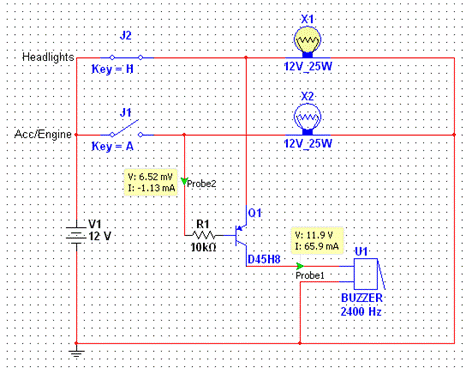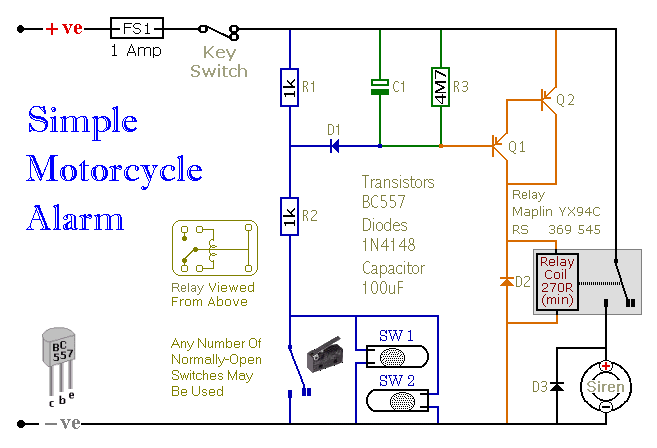
How To Build An Anti-Hijack Vehicle Alarm

Before installing this or any other engine cut-off device in a vehicle, it is essential to carefully evaluate the safety implications of potential failures and the legal ramifications of implementing a device that could result in an accident. If a decision is made to proceed, it is crucial to utilize the highest standards of materials and craftsmanship. The flowchart is another of Eric's suggestions, which will assist in visualizing how the alarm operates. It also clarifies the sequence of events that lead to siren activation and subsequent engine failure.
The installation of an engine cut-off device is a critical modification that necessitates thorough consideration of its design, functionality, and integration into the vehicle’s electrical system. The device typically consists of a relay or switch that interrupts the fuel supply or ignition circuit when triggered by an alarm system. This mechanism is designed to prevent unauthorized use of the vehicle, enhancing security.
The flowchart mentioned serves as a valuable tool for understanding the operational logic of the system. It outlines the steps involved in the activation of the alarm, including sensor detection, signal processing, and the eventual triggering of the siren. Upon detection of an unauthorized entry or tampering, the alarm system sends a signal to the relay, which then cuts off power to the engine, effectively immobilizing the vehicle.
When selecting materials for the installation, it is advisable to use components that conform to automotive standards to ensure reliability and durability under various environmental conditions. This includes using high-quality connectors, wiring, and a robust relay that can handle the current load without overheating or failing.
Safety testing should be performed to verify that the device functions correctly under all expected conditions, including power fluctuations and potential system failures. Additionally, it is important to consider the implications of a failed cut-off system, as it could lead to scenarios where the vehicle remains operational despite an alarm condition, potentially posing a safety risk.
Ultimately, a well-designed engine cut-off system can serve as an effective deterrent against vehicle theft while ensuring compliance with safety and legal standards. Proper installation and maintenance are paramount to achieving the intended security benefits without compromising the vehicle's operational integrity.Before fitting this or any other engine cut-out to your vehicle - carefully consider both the safety implications of its possible failure - and the legal consequences of installing a device that could cause an accident. If you decide to proceed - you will need to use the highest standards of materials and workmanship. The Flow Chart is another of Eric`s suggestions. It will help you to visualize how the alarm is operated. It also explains the sequence of events that lead to siren activation - and subsequent engine failure. 🔗 External reference
The installation of an engine cut-off device is a critical modification that necessitates thorough consideration of its design, functionality, and integration into the vehicle’s electrical system. The device typically consists of a relay or switch that interrupts the fuel supply or ignition circuit when triggered by an alarm system. This mechanism is designed to prevent unauthorized use of the vehicle, enhancing security.
The flowchart mentioned serves as a valuable tool for understanding the operational logic of the system. It outlines the steps involved in the activation of the alarm, including sensor detection, signal processing, and the eventual triggering of the siren. Upon detection of an unauthorized entry or tampering, the alarm system sends a signal to the relay, which then cuts off power to the engine, effectively immobilizing the vehicle.
When selecting materials for the installation, it is advisable to use components that conform to automotive standards to ensure reliability and durability under various environmental conditions. This includes using high-quality connectors, wiring, and a robust relay that can handle the current load without overheating or failing.
Safety testing should be performed to verify that the device functions correctly under all expected conditions, including power fluctuations and potential system failures. Additionally, it is important to consider the implications of a failed cut-off system, as it could lead to scenarios where the vehicle remains operational despite an alarm condition, potentially posing a safety risk.
Ultimately, a well-designed engine cut-off system can serve as an effective deterrent against vehicle theft while ensuring compliance with safety and legal standards. Proper installation and maintenance are paramount to achieving the intended security benefits without compromising the vehicle's operational integrity.Before fitting this or any other engine cut-out to your vehicle - carefully consider both the safety implications of its possible failure - and the legal consequences of installing a device that could cause an accident. If you decide to proceed - you will need to use the highest standards of materials and workmanship. The Flow Chart is another of Eric`s suggestions. It will help you to visualize how the alarm is operated. It also explains the sequence of events that lead to siren activation - and subsequent engine failure. 🔗 External reference





